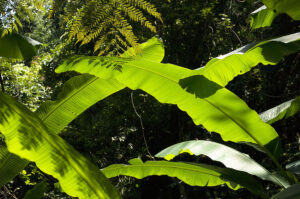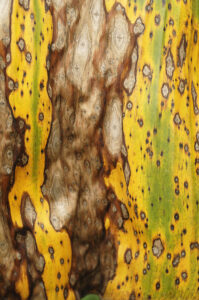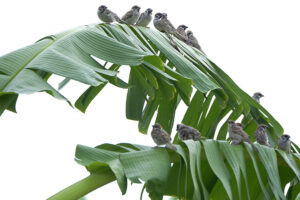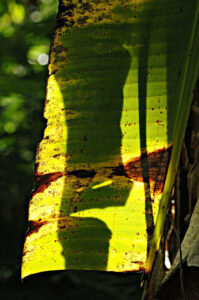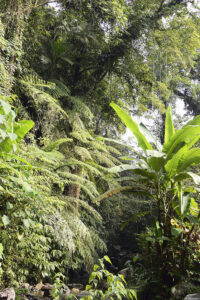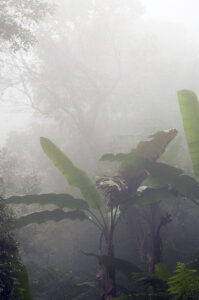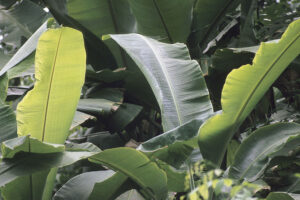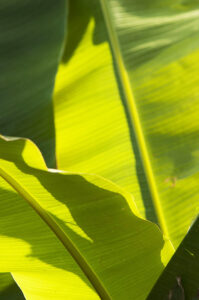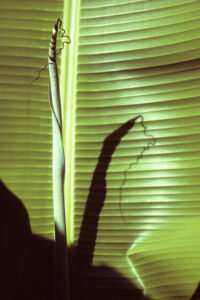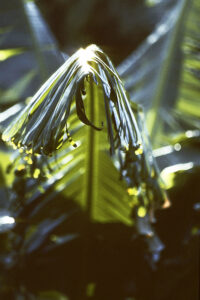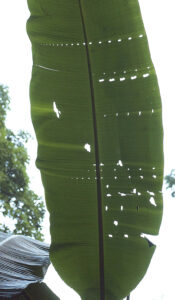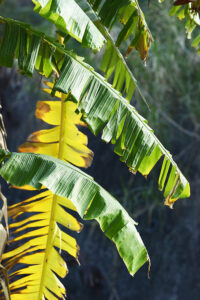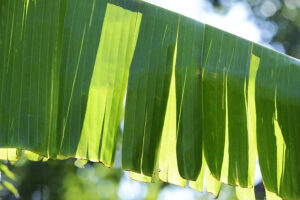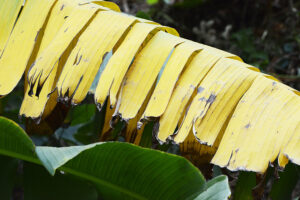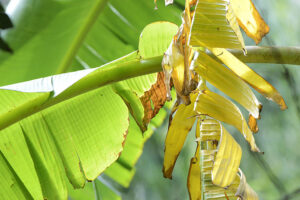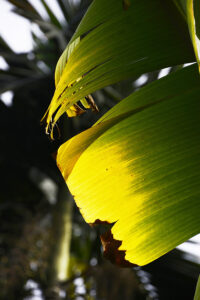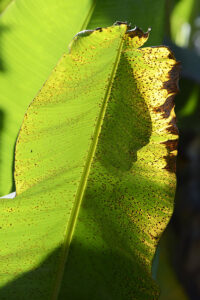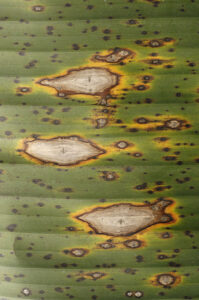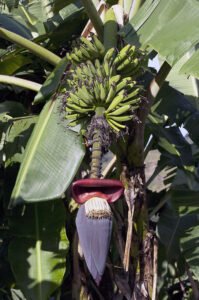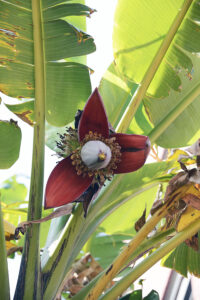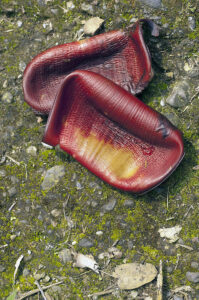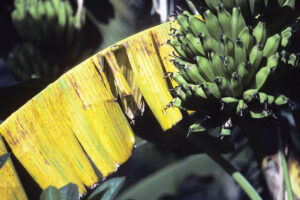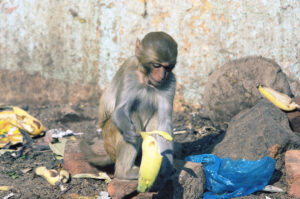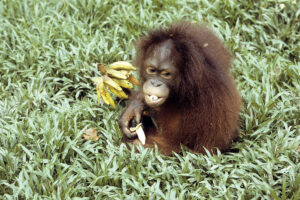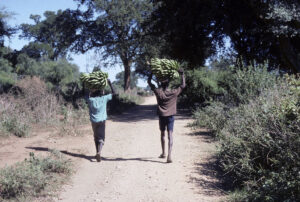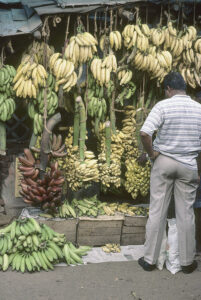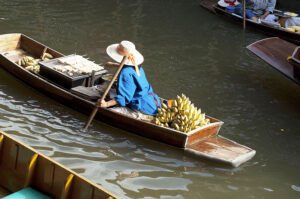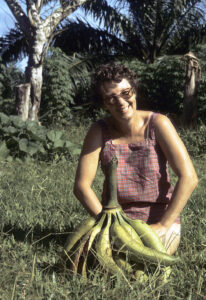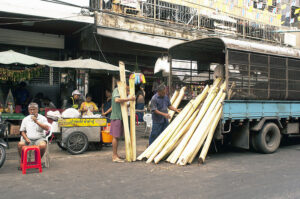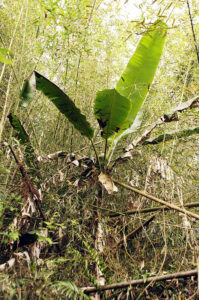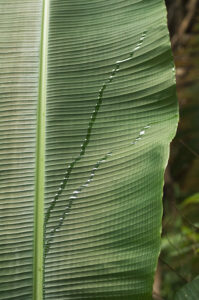Bananas
Montane forest with ferns and Taiwan banana (Musa formosana), Malabang National Forest, near Hsinchu, northern Taiwan. (Photo copyright © by Kaj Halberg)
Multi-coloured pattern on a withering banana leaf, Taiwan. (Photo copyright © by Kaj Halberg)
Tree sparrows (Passer montanus) resting on tattered banana leaves, Taichung, Taiwan. This bird is described on the page Animals – Birds: Birds in Taiwan. (Photo copyright © by Kaj Halberg)
This shadow of a banana leaf on another banana leaf resembles a gaping creature, wearing a tall hat. The picture was taken at the foot of the Rinjani Volcano, Lombok, Indonesia. (Photo copyright © by Kaj Halberg)
The tall and sturdy banana plants are often called banana trees or banana palms, but both these terms are erroneous, as the plant is actually a huge herb, whose ‘trunk’ consists of thick layers of modified, closely packed leaf-stalks, forming a so-called pseudostem (false stem), also called a corm.
These plants, comprising c. 30 species of the genus Musa, are native to subtropical and tropical areas, from India eastwards to Taiwan, and thence southwards through Southeast Asia, Indonesia, and New Guinea to northern Australia.
Rainforest with ferns and an unidentified banana species, observed outside the Hindu temple Pura Batukaru, Bali, Indonesia. (Photo copyright © by Kaj Halberg)
Foggy montane forest with Taiwan banana (Musa formosana), Malabang National Forest, near Hsinchu, northern Taiwan. (Photo copyright © by Kaj Halberg)
Leaves
Banana leaves grow in spirals and may be up to 2.7 m long and 60 cm wide. They are often tattered, torn into horizontal strips by the wind, often all the way to the midrib.
Banana leaves may grow up to 2.7 m long and 60 cm wide. These pictures are from south-western Sri Lanka (top), eastern Taiwan (centre), and Cambodia. (Photos copyright © by Kaj Halberg)
A young and rolled-up banana leaf casts a shadow on an older leaf, Ubud, Bali, Indonesia. (Photo copyright © by Kaj Halberg)
This tattered banana leaf, observed on the island of Lombok, Indonesia, resembles a wig. (Photo copyright © by Kaj Halberg)
When this leaf of Taiwan banana (Musa formosana) was young and still rolled up, insect larvae made tunnels through it, and when the leaf unfolded, these patterns were revealed. – Malabang National Forest, Hsinchu, Taiwan. (Photo copyright © by Kaj Halberg)
On this banana leaf, observed near Guoxing, western Taiwan, the shadow of a leaf with a fate similar to the one described above, creates the outline of a robot-like creature with an angular head. (Photo copyright © by Kaj Halberg)
Below is a collection of pictures, showing tattered banana leaves, all photographed in Taiwan.
(Photos copyright © by Kaj Halberg)
Withering banana leaves often show very beautiful patterns. The pictures below are all from Taiwan.
(Photos copyright © by Kaj Halberg)
Flower and fruit
When a banana plant is mature, a harder stem develops inside the pseudostem, emerging at the top of the plant, carrying a single, huge inflorescence. The fruits grow in several large clusters, sitting in rows down the stout flower stalk, each containing between 10 and 30 bananas. They are so heavy that the stalk is bent downwards.
Flower and fruits, Pokhara, Nepal. (Photo copyright © by Kaj Halberg)
Flowers, Taichung, Taiwan (top), and Cherangani Hills, Kenya. (Photos copyright © by Kaj Halberg)
Fallen bracts of an inflorescence, Gukeng, Taiwan. (Photo copyright © by Kaj Halberg)
Unripe banana bunch, Yeh Saneh, Bali, Indonesia. (Photo copyright © by Kaj Halberg)
Monkeys and apes love bananas, as is evident from the pictures below. – These animals are described in depth on the page Animals – Mammals: Monkeys and apes.
This young long-tailed macaque (Macaca fascicularis) is stuffing itself with bananas. It lives in the forest around the Wenara Wana Temple (popularly called ‘Monkey Forest’), near Ubud, Bali, Indonesia. (Photo copyright © by Kaj Halberg)
This young rhesus monkey (Macaca mulatta) is feeding on a banana outside the Buddhist temple on Mount Popa, Myanmar. (Photo copyright © by Kaj Halberg)
In Borneo, a number of rehabilitation centres for orangutans (Pongo pygmaeus) have been established, where orphaned young orangutans, which have been confiscated from poachers, are trained to live in the forest, after which they are released into safe areas, such as national parks. In 1985, I visited the Sepilok Orangutan Rehabilitation Centre, near the town of Sandakan, Sabah. This visit is related in detail on the page Travel episodes – Borneo 1985: Visiting orangutans.
This 8-year-old orangutan, named Juliana, lives in the forest around Sepilok. Occasionally, she comes to the centre to get bananas. She lost an arm, when she climbed a pole and got an electric shock. Her left arm became lame and had to be amputated. (Photo copyright © by Kaj Halberg)
Cultivation and usage
Bananas were probably first cultivated in New Guinea, and today they are grown worldwide in warmer countries. Most are grown for their edible fruits, raw or cooked, the latter often called plantains. Other types are cultivated for their fibres, to make wine and beer, or as ornamentals.
The huge leaves have a wide range of usage, being both flexible and waterproof. They are much utilized for wrapping, including in cooking, where various foods are often wrapped in the leaves before being steamed.
In various Hindu and Buddhist ceremonies, the leaves are used as decoration, often having a symbolic meaning. In former times, in India and Southeast Asia, banana leaves were used as writing material. Before the introduction of plastic, they were also utilized in many areas as rain ponchos.
Today, almost all edible bananas are cultivars of two wild species, Musa acuminata and M. balbisiana, and the hybrid between them, called Musa × paradisiaca. Formerly, the scientific name of edible bananas was Musa sapientum, which is no longer accepted.
Other species of banana include the scarlet Musa coccinea and the pink M. velutina, and the term also refers to members of the genus Ensete, including snow banana (E. glaucum) and false banana (E. ventricosum).
Banana plantation, Hanoi, Vietnam. (Photo copyright © by Kaj Halberg)
Men of the Pokot tribe, carrying bananas to a market, Sigor, Cherangani Hills, Kenya. (Photo copyright © by Kaj Halberg)
Various types of bananas for sale, Kannimera Market, Thiruvananthapuram, Kerala, South India. (Photos copyright © by Kaj Halberg)
Bananas, pumpkins, and lemons for sale at a market, Nyaung Shwe, Lake Inle, Myanmar. (Photo copyright © by Kaj Halberg)
At the ‘floating market’ in Damnoensaduak, Thailand, this woman is selling fried bananas from her boat. (Photo copyright © by Kaj Halberg)
Some types of cooking bananas are very large. – Sarawak, Borneo. (Photo copyright © by Kaj Halberg)
Pseudostems of banana plants are loaded onto a truck, Bangkok, Thailand. (Photo copyright © by Kaj Halberg)
Taiwan banana (Musa formosana)
This species, which may grow to 6 m tall, is endemic to Taiwan, growing on forested slopes, from near sea level to an altitude of about 1,000 m.
Bamboo forest with Taiwan banana, near Yuantan Waterfall, eastern Taiwan. (Photo copyright © by Kaj Halberg)
Shadows from ferns create patterns on leaves of Taiwan banana, Malabang National Forest, Hsinchu, northern Taiwan. (Photo copyright © by Kaj Halberg)
Rain water, running down a leaf of Taiwan banana, Malabang National Forest. (Photo copyright © by Kaj Halberg)
Fruits of Taiwan banana, Malabang National Forest. (Photo copyright © by Kaj Halberg)
(Uploaded February 2019)
(Latest update May 2023)
